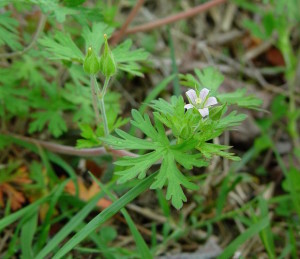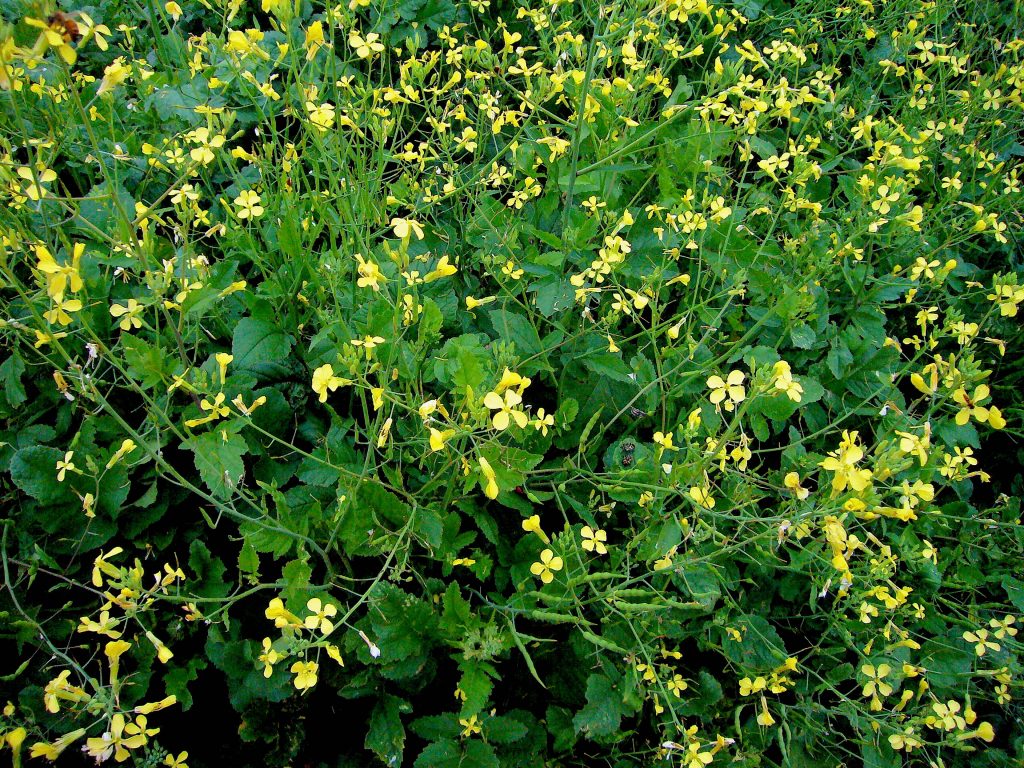
Wild Radish and Mustard are in blossom now. Photo by Green Deane

Tea Berry (Checkerberry) Can be found under the snow.
One can forage in the Wintertime even in snowy northern climes. I first realize this as a kid ice skating and seeing frozen cranberries and turtles swimming around under the ice. And of course, ice fishing is a way of life for a few months but also available are cattail rhizomes and shoots along with fresh water clams. Groundnuts can also be found near frozen waterways. Ad there are a few trees that hold onto fruit into cold weather, the sugarberry comes to mind, some times persimmons and apples though the persimmon will be better than most apples. Some plants germinate under the snow or keep their fruit until spring, teaberry and chickweed are two examples. South facing hills that lose their snow can often have wintertime edibles.
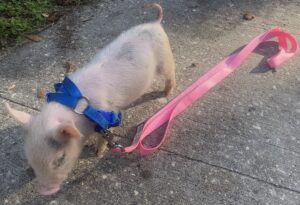
If Hamlet doesn’t behave I’ll change his name to SPAM. Photo by Green Deane.
My challenge this past fortnight has not been plants. A sow where I live had four piglets. Two were taken by a bobcat and a third fatally injured. The same bobcat that took all my ducks and chickens. I have been raising the fourth piglet as mom decided to have nothing to do with him. Called Hamlet, he’s still kicking and getting more active and noisy. I’ve finally got him to eat on his own, he likes warm towels and snuggling with a teddybear. Sleepy happiness is a heat lamp. Like baby squirrels, piglets have to be carefully fed or they will aspirate the milk, get pneumonia, and die. We’ve gone for a couple of walks, expanding his horizons.
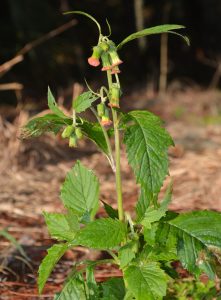
Redflowered Ragweed. Photo by Green Deane
Redlfower Ragweed isn’t a ragweed but I’ve been seeing it for a couple of years now. It reminds me of Fireweed/Burnweed except with large red blossoms. Botanically it’s Crassocephalum crepidioides (kras-oh-SEF-uh-lum krep-pid-dee-OY-deez.) Crassocephalum is from the Dead Latin “Crassus” meaning “thick” and “kephale” which is Greek for head. Crepidioides is more mangle Greek. “-oides” in Dead Latin is mispronounced borrowed Greek and means “resembles.” Crepidioides means “resembles Crepis.” Crepis is from an old Greek word for a frilly funeral veil. It works its way into English via French as “crepe” paper. So “thick head resembles crepe paper” is one way to interpret the plant’s name.” And… even though it is called the Redflower Ragweed its leaves resemble Fireweed/Burnweed, Erechtites hieraciifolius (which is an even more complicated, naughty story. Redflower Rageweed’s blossoms, however, resemble the toxic Florida Tassel Flower. Florida tassel flower has smoother less toothy eaves and is a smaller plant and can have pink blossoms.) Cornucopia II says of Crassocephalum crepidioides on page 37: “Ebolo, Okinawan Spinach, Young leaves and shoots are used as a potherb, fried, or mixed in Khao yam. The leaves are fleshy, tinged with purple and have a somewhat mucilaginous quality and nutty flavor. Has become quite popular on the island of Okinawa and in Hawaii In Thailand, the roots are eaten with chili sauce or cooked in fish curry. Tropical Africa. Cultivated.”
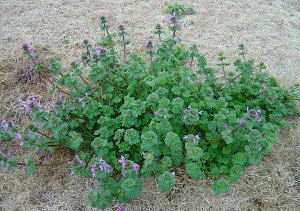 Henbit. is in the mint family but does not smell or taste minty. It does, however, have a square stem and the blossoms resembles mints. In northern climates it is one of the first green plants to pop up after the snow goes (it and chickweed.) Locally it likes our cooler months of the year. It was esteemed by the natives because among all the annual greens it is not spicy but rather mild if not on the sweet side. What can be confusing about it is that the leave shape and stem length is different from young to old leaves. But they all have a scalloped shape. It also has a similar looking relative that is also edible called Dead Nettle. You can read about Henbit here.
Henbit. is in the mint family but does not smell or taste minty. It does, however, have a square stem and the blossoms resembles mints. In northern climates it is one of the first green plants to pop up after the snow goes (it and chickweed.) Locally it likes our cooler months of the year. It was esteemed by the natives because among all the annual greens it is not spicy but rather mild if not on the sweet side. What can be confusing about it is that the leave shape and stem length is different from young to old leaves. But they all have a scalloped shape. It also has a similar looking relative that is also edible called Dead Nettle. You can read about Henbit here.
Also found in lawns this time of year are wild geraniums, usually Cranesbill or Stork’s Bill. (Why one is one word and the other two-words possessive I do not know.) Botanically they are Geranium carolinianum and Erodium circutarium. Neither is great foraging. In fact both are more medicinal than edible but they seem to get mention in a variety of foraging books. The problem is they are extremely bitter. You might be able to toss a little bit of both in a salad but that’s about the extent of it. If you have what you think is a Cranesbill or a Stork’s Bill but it has more of a bottle brush blossom than five petals you might have the non-edible Fumaria. It comes up this time of year and from a distance the leaves can remind one of the wild geraniums. To read more about them go here.

Classes are held rain or shine (but not during hurricanes.)
Foraging classes, we might be dodging passing storms this week.
Jan. 6th, Eagle Park Lake, 1800 Keene Road, Largo, FL 33771. Meet at the pavilion near the dog park, 9 a.m. to noon.
Jan. 7th Mead Garden,1500 S. Denning Dr., Winter Park, FL 32789, 9 a.m. to noon, meet at the bathrooms.
Jan. 13th Wickham Park: 2500 Parkway Drive, Melbourne, FL 32935-2335, meet at the dog park, 9 a.m. to noon.
Jan. 14th Bayshore Live Oak Park, Bayshore Drive. Port Charlotte, meet at the parking lot at Bayshore and Ganyard. 9 a.m. to noon.

Ripe fruit of the Spanish Cherry tree.
It is called the Spanish cherry or the Bullet Tree, thus I slipped up in class and called it the Spanish bullet tree, botanically it’s Mimusops elingi, and related to the Mimusops coriacea, neither of which are anything to write home about. While the fruit of the Spanish cherry tree is edible it needs the attention of a dessert chef to make it tasty. Off the tree the astringent fruit has a granular texture and a flavor reminiscent of persimmons. They look better than they taste. That said, I have only had one tree to go by and that is in Dreher Park in West Palm Beach. I’ve never seen the tree elsewhere. Fruiting heavily now, in Dreher it is adjacent to a pedestrian entrance at the west end of McIntosh Street.

You get the USB, not the key.
172-video USB would be a good end of spring present and is now $99. My nine-DVD set of 135 videos has been phased out. The USB videos are the same videos I have on You Tube. Some people like to have their own copy. The USB videos have to be copied to your computer to play. If you want to order the USB go to the DVD/USB order button on the top right of this page. That will take you to an order form. I’d like to thank all of you who ordered the DVD set over the years which required me to burn over 5,000 DVDs individually.

Green Deane Forum
Want to identify a plant? Perhaps you’re looking for a foraging reference? You might have a UFO, an Unidentified Flowering Object, you want identified. On the Green Deane Forum we — including Green Deane and others from around the world — chat about foraging all year. And it’s not just about warm-weather plants or just North American flora. Many nations share common weeds so there’s a lot to talk. There’s also more than weeds. The reference section has information for foraging around the world. There are also
articles on food preservation, and forgotten skills from making bows to fermenting food.
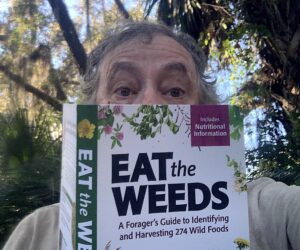
Finally, a physical copy of the book.
Now in print and available is EatTheWeeds, the book. It has 274 plants, 367 pages, index, nutrition charts and color photos. It’s available at Amazon. and other locations. Most of the entries include a nutritional profile and if no profile reported then noteworthy constituents, such as anti-oxidants. I have no doubt that the book will outlive me, my little contribution to posterity.
This is weekly newsletter #583. If you want to subscribe to this free newsletter you can find the sign-up form in the menu at the top of the page.

